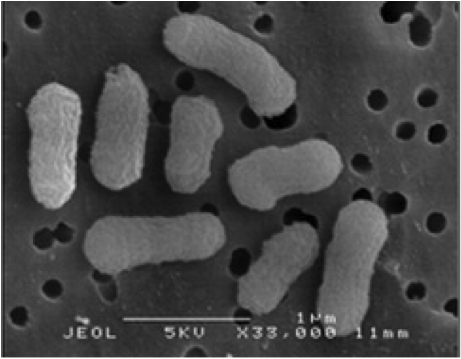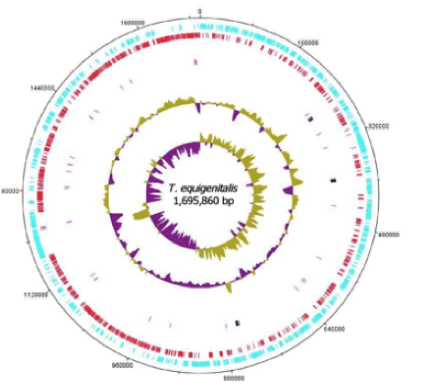Taylorella equigenitalis MCE9
A Microbial Biorealm page on the genus Taylorella equigenitalis MCE9
Classification
Higher order taxa
Kingdom: Bacteria Phylum: Proteobacteria Class: Beta-proteobacteria Order: Burkholderiales Family: Alcaligenasceae Genus: Taylorella
[Others may be used. Use NCBI link to find]
Species
Species: equigenitalis
Description and significance
Discovered in 1977 in England (2), Taylorella equigenitalis is a non-motile, coccobaccili, microaerophilic, gram-negative bacteria. T. equingenitalis strain MCE9 is the cause of a sexually transmitted infection in horses known as Contagious Equine Metritis (CEM), an inflammatory sexually transmitted disease that is found in both gender of horses. (6)
Genome structure
The genome structure in T. equingenitalis is a single, circular chromosome. Within the chromosome the genome has been found to be about 1,638,559 base pairs long. The G+C content is calculated to be about 38.3%. The amount of protein coding genes is about 1,534 and is an average of 987 base pairs in long. Plasmids have not been found present in the genome of T. equigenitalis. (4)
Cell and colony structure
The cell structure of T. equigenitalis is a gram-negative bacteria, which possesses lipopolysaccharides within the cell wall. (4) These polysaccharides contain O-antigens, which could contribute partially to the causation of CEM. (3) Pili are used in vivo by T. equingenitalis to form colonies, otherwise they are non-motile. (5) A typical colony structure for T. equigenitalis tends to be about 2-2.5 mm in size and a greyish yellow color with distinct edges. (5)
Metabolism
T. equigenitalis is an aerobic bacteria that uses oxygen as its primary electron acceptor. T. equigenitalis is a fastidious bacteria in need of a specific environment to grow and function. T. equigenitalis does not use glycolysis for facilitation of energy, but is reliant on the TCA cycle and oxidative phosphorylation. Energy resources and carbon uptake are derived from malate, glutamate and alpha-ketoglutarate. (4) These resources feed directly into the TCA cycle and other central metabolic pathways to provide the tools necessary to synthesize the 13 precursor metabolites.
Ecology
Taylorella equigenitalis inhabits the genitalia of horses, species Equus. In mares it has T. equingenitalis has been located on the central clitoral sinus on mares and the urethral fossa in stallions primarily.(5) Live breeding or certain conditions when using frozen semen can spread the STD. (6) This bacteria prefers temperatures of around 37°C.(4) Any higher or lower and the bacteria will not survive due to its need for rich media. (1) Isolation of the bacteria is also difficult due to its fastidious needs, requirement for reduced oxygen conditions, and other non-pathogenic micro-organisms out growing it. (5) This makes T. equigneitalis more challenging to identify. (5) Often times a rich agar such as CEMO agar or horse blood agar has the specific nutrients required for growth, which takes about 2-6 days. (5)
Pathology
Taylorella equigenitalis is the cause of a sexually transmitted infection in horses known as CEM. CEM generally is not fatal. CEM is generally carried and transmitted by the stallion to the mare. In the stallion no clinical signs of disease are present. (5,6) Once the disease is contracted in the mare the most common affect is infertility. (6) In pregnant mares abortion is expected. Other effects in mares such as cervicitus, endometritis and varying severities of vaginitis can occur and occasionally have fatal outcomes. (6) Horses with CEM cannot be transported across country lines legally and due to the difficulty in identifying the bacteria this causes the sexually transmitted disease to be an economic issue. CEM can be treated by use of antibiotics, such as penicillin, however it is difficult to eradicate. (5) Taylorella equigenitalis closest relative by phylogeny can cause CEM found in Donkeys, Equus Asinus.
References
1.) Amy B. Arata, J. Michael Donahue, Debra L. Earley, Johan Goris, Lori M. Hansen, Dwight C. Hirsh, Spencer S. Jang, Peter J. Timoney and Peter A. R. Vandamme. (2001) Taylorella asinigenitalis sp. nov., a bacterium isolated from the genital tract of male donkeys (Equus asinus). International Journal of Systematic and Evolutionary Microbiology 51, 971–976. Printed in Great Britain.
2.) S. Kagawa, M. Matsuda, B.C. Millar, J.E. Moore, O. Murayama, J.E. Moore, T. Sekizuka and A. Tazumi. (2006) Homogeneity of the 16S rDNA sequence among geographically disparate isolates of Taylorella equigenitalis. BMC Veterinary Research 2:1. DOI:10.1186/1746-6148-2-1
3.) Jean-Michel Batto, Marie-France Breuil, Fabien Duquesne, Lauren Hebert, Claire Laugier, Bouziane Moumen, Pierre Renault, and Sandrine Petry. (2011) Genome Sequence of Taylorella equigenitalis MCE9, the Causative Agent of Contagious Equine Metritis. J Bacteriol. April; 193(7): 1785. Published online 2011 January 28. DOI: 10.1128/JB.01547-10.
4.) Breuil M.-F., Duquesne F., Hébert L., Moumen B., Pons N., et al. (2012) Genomic Characterization of the Taylorella Genus. PLoS ONE 7(1): e29953. DOI:10.1371/journal.pone.0029953.
5.) T.C. Buckley, B.C. Millar, J.E. Moore, and J. Xu. (2001) Possible misidentification of Bacteroides sp., probably B. ureolyticus as Taylorella equigenitalis: Implications for the laboratory diagnosis of CEM. Northern Ireland Public Health Laboratory, Department of Bacteriology, Belfast City Hospital, Belfast BT9 7AD, Northern Ireland b Irish Equine Centre, Johnstown, Naas, Co. Kildare, Ireland. Pgs 611-616
6.) World Organization for Animal Health (2012) Contagious Equine Metritis, OIE Terrestrial Manual, 7th edition , Vol. 2, Chapter 2.5.2, pp. 1-7.
Edited by Hannah Estabrook of Dr. Lisa R. Moore, University of Southern Maine, Department of Biological Sciences, http://www.usm.maine.edu/bio


